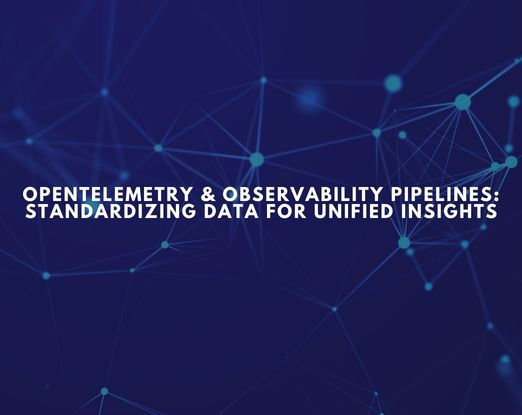Introduction: Unlocking the Power of Observability
In today’s dynamic software landscape, the need for standardized observability practices has never been more critical. In this blog post, we will delve into OpenTelemetry and observability pipelines, exploring how they reshape data collection, processing, and analysis to provide unified insights. You’ll learn about the significance of these frameworks in achieving consistent logs, metrics, and traces across distributed systems, ultimately enhancing performance and reliability.
Throughout this article, we will discuss the importance of unified insights in fostering collaboration among platform engineers, DevOps teams, and Site Reliability Engineers (SREs). By standardizing data collection methods, organizations can better manage their applications and gain actionable insights that drive system enhancements.
Section 1: What is OpenTelemetry?
OpenTelemetry is an open-source framework specifically designed for collecting telemetry data from various systems and applications. It operates under the principle of providing developers and operators with a standardized way to instrument their software, enabling effective observability practices across different environments.
The primary function of OpenTelemetry is to help organizations unify how they approach logging, tracing, and metrics across their infrastructure. By integrating powerful features such as automatic instrumentation and support for multiple programming languages, OpenTelemetry empowers teams to gather and utilize telemetry data seamlessly.
Section 2: The Role of Observability Pipelines
Observability pipelines play a crucial role in modern data processing, as they provide a structured approach to handling telemetry data. Essentially, observability pipelines gather, enrich, and forward telemetry data to various backends, ensuring that the information is accurate and actionable.
One of the main challenges organizations face is data fragmentation, where telemetry data is scattered across numerous tools and platforms. Observability pipelines address this issue by ensuring consistent data processing while maintaining scalability. This consistency is essential for obtaining reliable analytics and deriving valuable insights about system behavior.
Section 3: Benefits of OpenTelemetry & Observability Pipelines
Adopting OpenTelemetry and observability pipelines offers numerous advantages for organizations. One significant benefit is the reduction of tool fragmentation, enabling teams to consolidate various monitoring tools into a cohesive observability framework. This consolidation simplifies operations and minimizes the complexities associated with managing disparate systems.
Moreover, organizations can experience a marked reduction in operational overhead by standardizing their observability practices. By simplifying the observability toolchain, onboarding new DevOps and SRE team members becomes easier while lowering long-term maintenance costs.
Section 4: Implementing OpenTelemetry & Observability Pipelines in Your Stack
For platform engineers and DevOps teams looking to upgrade their observability practices, implementing OpenTelemetry and observability pipelines can be a game-changer. Best practices for implementation include conducting thorough assessments of existing observability setups, choosing the right integrations, and ensuring team alignment on observability goals.
However, common pitfalls may arise during the implementation process. Teams might encounter challenges related to data silos, integration compatibilities, or insufficient training. By proactively addressing these issues and establishing clear communication channels, organizations can facilitate smoother transitions to standardized observability practices.
Section 5: Driving Business Value Through Unified Insights
Linking technical improvements from OpenTelemetry and observability pipelines to tangible business outcomes is vital for building a compelling case for adoption. Unified insights allow organizations to resolve issues more quickly, enhancing overall system performance and user satisfaction.
Moreover, numerous case studies suggest that businesses adopting these standardized practices often see a significant return on investment (ROI). By minimizing downtime and improving system stability, organizations can enhance customer experiences, ultimately leading to improved conversion rates and sustained growth.
Conclusion: Join the Movement for Unified Observability
As we conclude this exploration of OpenTelemetry and observability pipelines, we encourage readers to consider how their organizations can adopt these practices for improved visibility and performance. By embracing unified observability, businesses can establish healthier systems and foster a culture of continuous improvement.
We invite you to share your thoughts or experiences in the comments below. Have you faced observability challenges in your environment? Have you started implementing OpenTelemetry? Don’t forget to subscribe to our blog for more insights on modern observability strategies, and feel free to share this post with your teams or on social networks for broader discussion.
Frequently Asked Questions
OpenTelemetry is an open-source framework designed for collecting telemetry data from various systems and applications, providing a standardized way to instrument software for effective observability.
Observability pipelines gather, enrich, and forward telemetry data to various backends, ensuring consistent data processing and addressing issues of data fragmentation across different tools and platforms.
Using OpenTelemetry helps reduce tool fragmentation, consolidates monitoring systems into a cohesive framework, simplifies operations, and lowers long-term maintenance costs.
Standardizing observability practices enables organizations to better manage their applications, enhance performance, and gain actionable insights that drive system improvements.
Challenges during implementation may include data silos, integration compatibilities, and insufficient training for team members on the new observability practices.
Unified insights from OpenTelemetry and observability pipelines allow organizations to quickly resolve issues, enhance system performance, improve customer experiences, and achieve a significant return on investment (ROI).
Best practices include thoroughly assessing existing observability setups, choosing the right integrations, and ensuring team alignment on observability goals.
Telemetry data like logs, traces, and metrics is crucial for understanding system behavior, monitoring performance, and diagnosing problems effectively across distributed systems.
Yes, OpenTelemetry supports multiple programming languages, allowing diverse teams to instrument their software without being restricted to a single language ecosystem.
By standardizing data collection methods, OpenTelemetry and observability pipelines foster collaboration among platform engineers, DevOps teams, and SREs by providing consistent data that can be shared and acted upon across teams.
